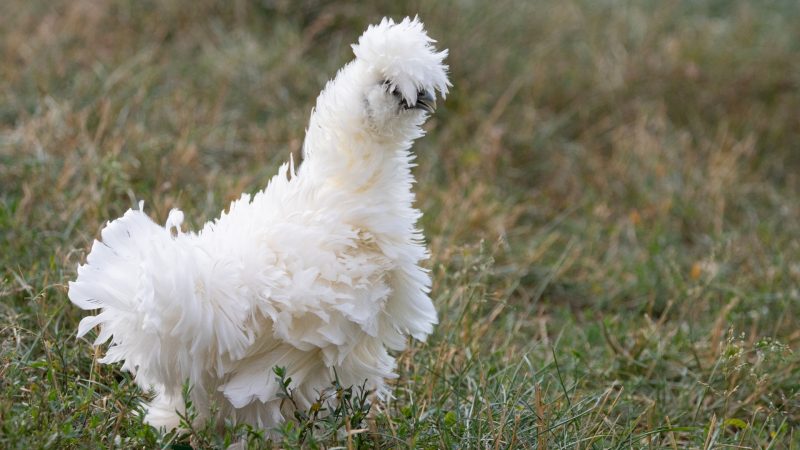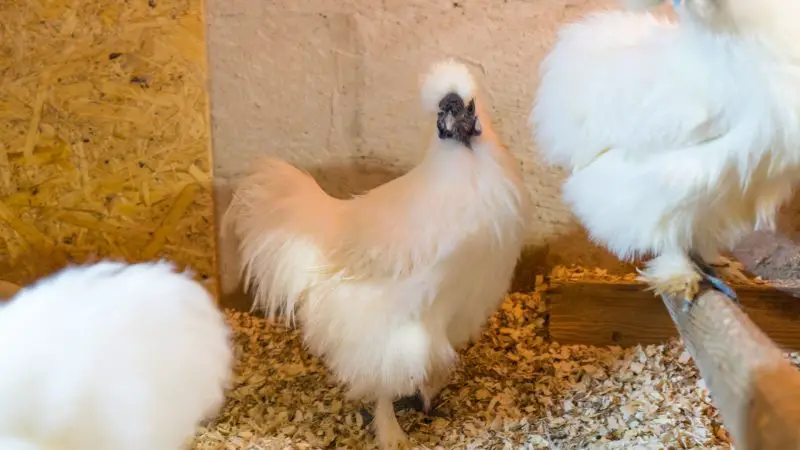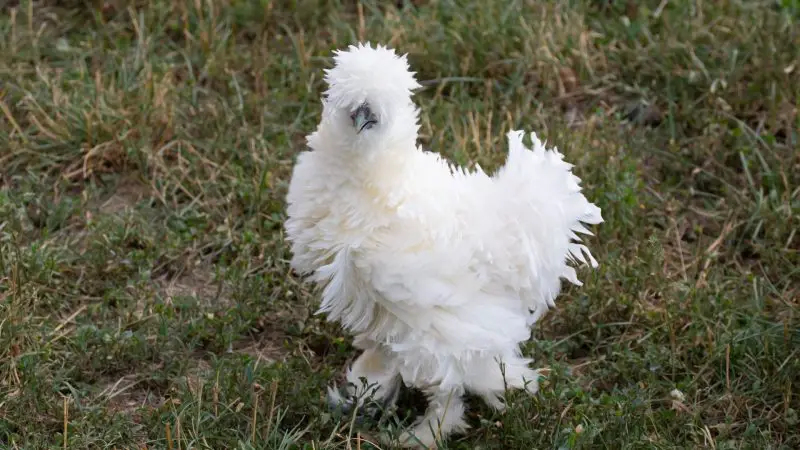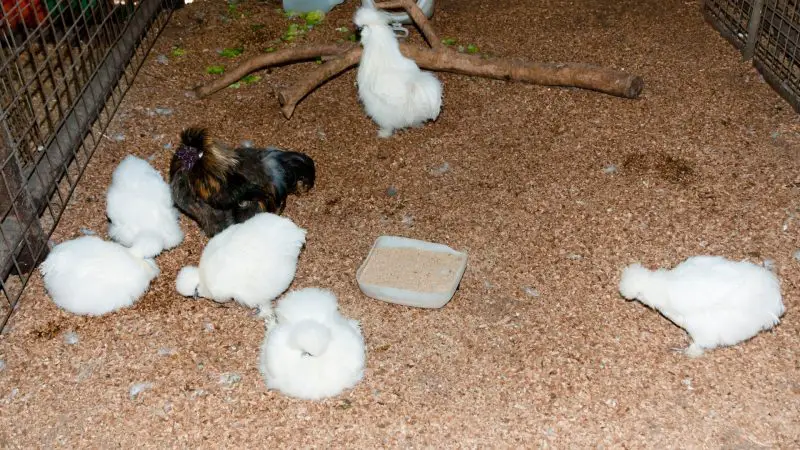With many chicken breeds out there, finding one that suits your unique farming needs can prove daunting. While some breeds are known to be layers, others like Silkies are widely viewed as pets due to their unique appearance, warm personality, and brooding tendencies.
What is a Silkie chicken? A Silkie chicken is a breed known for its fluffy plumage that feels like silk. Silkies are considered to be among the cutest chicken breeds due to their unique fluffy looks. Although they are not the best layers, they are known for their calm demeanor, motherly instincts, and friendliness.
This article will take a deeper look at the Silkie chicken breed, analyzing its main characteristics, physical appearance, personality, advantages, and even disadvantages.
What Does a Silkie Chicken Look Like?

Silkie chickens have fluffy feathers that contribute to their unique appearance. They also have dark blue bones and skin, blue earlobes, and five toes on each foot. Silkies come in different colors from black to blue, red, buff, reddish-brown, and most commonly, white.
Its feathers can be so prominent that they cover their faces and legs, giving them the appearance of walking cotton candies.
Silkies’ dark skin is caused by a gene mutation called Fibromelanosis, while the fluffy feathers are caused by a gene that prevents their pennaceous feathers from developing hooklets. This gene makes the bird have soft silk-like feathers.
Related: 9 Chickens With Fluffy Heads | Information and Facts
What Does a Male Silkie Chicken Look Like?
Male Silkie chickens have large combs and a round wattle. Their feathers also tend to slightly resemble those of other chicken breeds as they are long and pointed. Rooster silkies are also larger than female silkies.
How Can You Tell if a Silkie Is Male or Female?
You can tell if a Silkie is male because it has a larger comb than that of a female Silkie. It also has a comparatively larger body than a female Silkie. Like other chicken breeds, rooster Silkies crow while hens don’t, and hen Silkies lay eggs while roosters don’t.
Silkies also take longer to mature, and distinguishing between male and female silkies can be hard while they’re still young.
Related: Male and Female Silkies | How to Identify Them?
Advantages of a Silkie Chicken

- Silkies are great feeders as they eat any insects they come across. Their strong appetite for insects means they can be used as a natural pest control technique.
- A Silkie will also lay eggs (although not as frequently as other breeds). It can be sold or consumed depending on personal preferences.
- The broody nature of Silkies makes them ideal for incubating and raising other poultry chicks. This explains why they are commonly used as sitters when farmers want to hatch their duck and Guinea fowl eggs.
- Silkies are also easy to maintain, especially for farmers with small spaces. This chicken breed can’t hop high or fly, making it easy to manage and keep them happy in a small backyard.
- As calm birds, farmers won’t have to deal with socialization issues when breeding Silkies with other breeds. They are passive and highly sociable, which makes them ideal for a variety of farm settings.
Disadvantages of a Silkie Chicken

- Silkie chickens lay eggs that are significantly smaller than standard eggs. This explains why they are not the first choice breed when it comes to laying eggs.
- Silkies are also less likely to escape or survive predatory attack due to their docile nature. These gentle birds are easily bullied and forced into submission, which is why they must be bred in a controlled environment.
- The fluffy, aesthetically appealing feathers of Silkie chickens are easy targets for fleas, mites, and lice. This translates to more work, especially in terms of grooming and maintenance on the owner’s side.
- Silkies are more expensive than other breeds. Owners will need to part with more cash to acquire them from trusted breeders compared to other chicken breeds.
Can You Eat Silkie Chicken?
You can eat Silkie chicken as an oriental dish. Their meat and bones are black and can be off-putting to some. However, a Silkie tastes just like normal chicken and is safe for consumption.
Behind the thick fluff, Silkies have a lesser meat content than other breeds. They are often eaten in Asian countries such as China, Cambodia, Japan, and Korea, believing they have special medicinal advantages.
Can Silkies Swim?
Silkies cannot swim because their feathers easily get wet as they don’t have barbs. Their lack of barbs, which causes their feathers to be fluffy, makes their wings unable to hold air. Hence, when in water, they will soak quickly and struggle to stay afloat.
As a good rule of thumb, Silkies shouldn’t be allowed to play or move around large water sources unsupervised. This breed isn’t a good swimmer and will sink shortly after being submerged in water.
Can Silkies Stay Outside During Winter?
Silkies shouldn’t stay outside during winter as the cold can be too much for them to bear. Though they’re fluffy, which keeps them extra warm, cold winter weather can take a toll on them. Like other domesticated animals, they should be supervised and have a warm shelter.
At Around What Age Do Silkies Start Laying Eggs?
Silkies lay eggs from between 7 to 9 months. Some lay when they’re older. A Silkie that starts laying at an older age means they’ll lay longer. Proper feeding ensures the chicken has good growth before its laying age and maintains proper nutrition during the laying period.
How to Raise a Silkie Chicken?

To raise a Silkie chicken, you may consider doing the following:
- Give them a balanced diet to ensure they’re healthy. Though they don’t need any special dietary requirements, Silkies thrive on protein-rich diets supplemented with vegetation, grains, and seeds to keep them fit and hyperactive.
- Monitor them regularly for pest infestations, such as mice or lice infestations, and diseases. Their fluffy feathers make them ideal breeding grounds for disease-causing pests.
- Changing beddings regularly should help keep the coop clean and pest-free.
- Before getting a Silkie, it’s advisable to check around and buy from a reputable breeder. Buying from a reputable breeder will give you the peace of mind that you’re buying healthy chicks. Reputable breeders are those whose flocks are certified by the National Poultry Improvement Plan (NPIP).
- As your Silkie’s eggs hatch, you must pay attention as the chicks may find it hard to get out of the hardened shells.
- Ensure that you have a well-prepared coop before bringing a silkie chicken home. These chickens aren’t the largest and, therefore, won’t need extremely large coops. However, you should ensure the coop is spacious enough to accommodate the exact number of Silkies you plan to keep.
- Silkie chickens also need a sturdy coop to protect them from predators. When building one, you should use strong timber, locks, and galvanized wire mesh.
How to Wash a Silkie Chicken?
Although it is not required, washing your Silkie chickens can help in keeping potentially harmful pests at bay.
To wash a Silkie chicken, here are some simple steps to observe:
Step 1: Mix poultry shampoo like the Carefree Enzymes Shampoo (available at Amazon) with warm water in a basin, then place your Silkie inside.
- Perfect for washing Birds before competitions
- Gentle on Birds, tough on dirt and grime
- Apple scented
- Non-toxic & food Grade
- Improves bird hygiene
Step 2: While avoiding the eyes and nose, wash the Silkie using your fingers and ensure the water reaches all other body parts.
Step 3: Rinse and dry them thoroughly, paying special attention to areas under the wings.
Silkies dust-bath and preen themselves, eliminating the need for frequent washing. But in case you notice the dirt building up, you can easily prepare a quick bath by observing the tips above.
List of Sources
National Poultry Improvement Plan (NPIP)
A Cis-Regulatory Mutation of PDSS2 Causes Silky-Feather in Chickens

